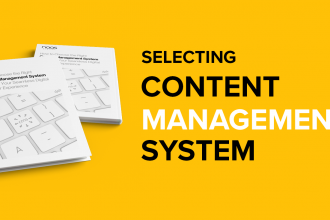Roadmap for your digital strategy
In an increasingly digital landscape, a robust digital strategy is indispensable for the growth and prosperity of your business. A meticulously devised plan empowers you to establish attainable objectives, adeptly monitor progress, and adapt as needed.
Creating a digital strategy can often appear intricate and convoluted. This is where our Digital Strategy Roadmap guide steps in to simplify the process for you. This comprehensive guide streamlines the journey into five manageable steps, equipping you with the essential tools for crafting a practical and efficient digital strategy roadmap, accompanied by insights from our trusted partners.
In this article, we will provide a high-level overview of the five steps to create a digital strategy roadmap
Step 1: Defining Objectives
The inaugural step in your roadmap is objective setting. Objectives should adhere to the SMART (Specific, Measurable, Achievable, Realistic, and Time-bound) criteria. These objectives should encompass short-term, mid-term, and long-term targets, clearly articulating the baseline statistics, future objectives, and expected achievement timelines. These goals, be they quarterly, annual, or spanning two to five years, must directly contribute to your revenue and market share objectives.
Striking the right balance is vital. Too few goals may render the strategy vague, while too many can obscure the focus on pivotal objectives. It’s imperative to establish the processes, communication channels, and working methods that facilitate success and growth. Regular quarterly reviews are essential to track progress and identify areas in need of attention. Make sure these goals are visible and shared across your organization to ensure alignment and a shared sense of purpose.
Step 2: Identifying KPIs
Key Performance Indicators (KPIs) serve as the yardstick for measuring the success of your goals and objectives. They offer insights into customer experience, financial performance, operational efficiencies, and more.
KPIs should be tracked at a frequency that aligns with the pace of your business – real-time, daily, weekly, monthly, quarterly, or bi-annually. When setting KPIs, start with your long-term objectives and then define your short-term targets. Accountability is paramount – each KPI should have an owner responsible for monitoring and achieving the set targets. Flexibility is key; reevaluate KPI targets periodically to ensure they remain realistic and attainable.
Step 3: Planning Activities and Projects
After setting your goals and KPIs, the next step is to identify and plan activities and projects. This is typically done in two scenarios:
- Lack of a clear backlog or understanding of required projects and activities.
- A basic understanding of key projects and activities required.
In both scenarios, activities and projects should be validated and prioritized based on a cost-benefit analysis. This process may involve identifying gaps and opportunities in your current strategy or validating existing projects against your goals and success factors. Once your activities are defined, a straightforward prioritization method is essential to focus on high-impact tasks first.
Step 4: Establishing Thematic High-Level Planning
This step entails identifying emerging themes in your activity planning, which will serve as the foundation for your roadmap. These themes, such as enhancing site performance or improving customer experience, should group similar activities, projects, or initiatives together.
Ensure you allocate high-level budgets (in hours) for each theme and reserve some budget for maintenance (upgrades, bug fixes, security updates). This will provide a clearer picture of the total investment required in each area.
Step 5: Crafting a Visual Time-Based Roadmap
The final step is the creation of a visual, time-based roadmap. This roadmap serves as your visual guide to your journey and how to reach your destination. By plotting themes and key milestones on a timeline, you can effectively communicate your plans. Your roadmap should be adaptable and easy to update to accommodate the ever-evolving needs and goals of your business. Pay attention to the time allocation for bug fixing and maintenance, ensuring that your roadmap is not hindered by these essential activities. Consider the tools you will use for your roadmap, selecting one that provides a high-level overview for stakeholders and a detailed view for the team responsible for executing the tasks.
How NAAS Digital Can Assist
NAAS Digital collaborates with retailers, brands, and manufacturers to accelerate their digital growth. A critical component of this success lies in having a clear understanding of your business’s direction and the motivations driving your chosen path. We support our clients in formulating and cultivating their digital strategies across various domains, including digital commerce, content management, data management, insights, and activation. Our approach involves tailoring technical solutions to meet the unique needs of each business.
A well-crafted digital strategy roadmap serves as your guide in the competitive business landscape. It goes beyond setting goals and defining KPIs; it consolidates these critical elements – goals, KPIs, activities, and visual plans – into a coherent, adaptable strategy that propels your business toward its vision. With this roadmap, you’re not merely contemplating success; you’re actively planning for it.










